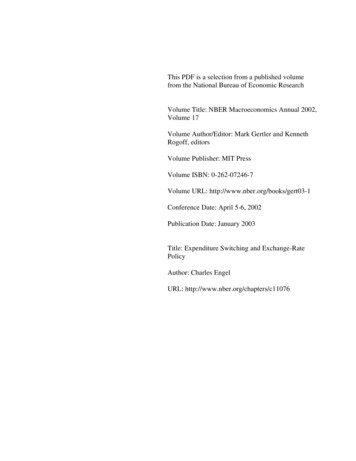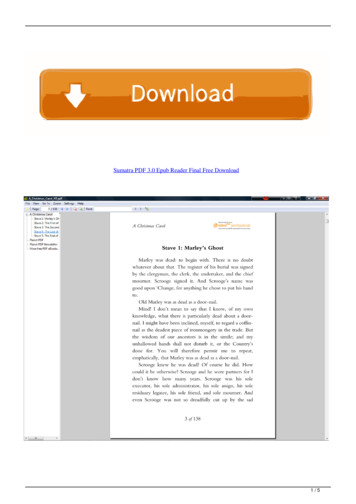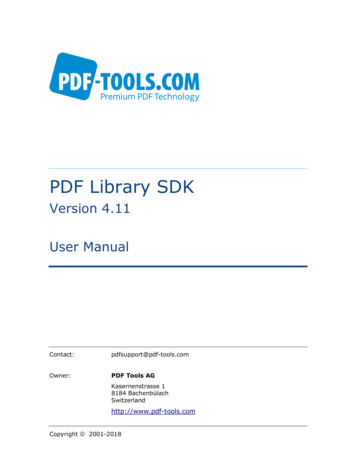
Transcription
This PDF is a selection from a published volumefrom the National Bureau of Economic ResearchVolume Title: NBER Macroeconomics Annual 2002,Volume 17Volume Author/Editor: Mark Gertler and KennethRogoff, editorsVolume Publisher: MIT PressVolume ISBN: 0-262-07246-7Volume URL: http://www.nber.org/books/gert03-1Conference Date: April 5-6, 2002Publication Date: January 2003Title: Expenditure Switching and Exchange-RatePolicyAuthor: Charles EngelURL: http://www.nber.org/chapters/c11076
Charles EngelUNIVERSITYOF WISCONSINAND NBERExpenditure SwitchingandExchange-RatePolicy1. IntroductionExchange-rate flexibility, it has been argued, is useful because it facilitatesrelative price adjustment among countries. Currency depreciation is aquick and painless way to lower domestic prices relative to foreign prices.Much attention has been paid recently to the benefits of exchange-ratestability in emerging economies. That literature has focused on the potential for greater monetary and financial stability from either fixing exchange rates or taking more extreme measures such as adopting acurrency board or dollarizing. But that analysis is not directly applicableto the choices facing many advanced countries-such as the decision toadopt the euro for some European countries. These countries uniformlyhave stable monetary policies (at least as stable as the policy conductedby the European Central Bank) and have deep, well-regulated financialmarkets. The economic benefit of adopting the euro lies in the increasedefficiency of transactions and the elimination of uninsurable exchangerate risk. On the other hand, a country adopting the euro cedes its monetary policy to the European Central Bank, and no longer has the optionof using monetary policy to respond to local conditions. Furthermore,adopting the euro eliminates one possible avenue for adjustment betweencountries-the relative price changes induced by exchange-rate movements. It is this latter effect that is the focus of this study.Recent evidence has found that consumer prices in rich countries areThe National Science Foundation has supported this research through a grant to the University of Wisconsin-Madison. I thank the discussants, Karen Lewis and Pierre Olivier Gourinchas, as well as Mick Devereux and Ken West, for helpful comments, and Akito Matsumotoand Shiu-Sheng Chen for excellent research assistance.
232 ENGELnot much affected by nominal exchange-rate changes in the short run.1This finding may imply that nominal-exchange-rate changes do not playmuch of a role in changing relative prices of goods. If consumer pricesare not responsive to exchange rates, then a depreciation of the homecurrency, for example, does not increase much the price that consumerspay for imported goods. However, there are other interpretations of theevidence on exchange rates and consumer prices. For example, theremight be important relative price effects but not for final consumer goods.One possibility is that intermediate firms substitute between domesticand foreign goods according to relative price changes, but set prices forconsumers in a way that is unresponsive to exchange-rate changes.The extent to which exchange rates alter relative prices may be important for determining the desirability of exchange-rate flexibility amongadvanced nations. Milton Friedman (1953), an early advocate of flexibleexchange rates, argued that one advantage of floating rates is that theycould allow rapid change in relative prices between countries (p. 162):A rise in the exchangerate. makes foreigngoods cheaperin termsof domestic currency,even though their prices are unchanged in terms of their owncurrency,and domestic goods more expensive in terms of foreign currency,even though their prices are unchanged in terms of domestic currency.Thistends to increaseimports [and] reduce exports.This passage makes two assumptions: that goods prices are unchangedin the currency of the producer of the good, and that there is significantpassthrough of the exchange-rate change to the buyer of the good. Onthe nominal-price stickiness, Friedman argues that the choice of exchangerate regime would matter little if nominal goods prices adjusted quicklyto shocks (p. 165):If internal prices were as flexible as exchange rates, it would make little economic difference whether adjustments were brought about by changes in exchange rates or by equivalent changes in internal prices. But this condition isclearly not fulfilled. At least in the modem world, internal prices are highlyinflexible.In assessing this relative-price effect and its significance for the choiceof exchange-rate regime, Friedman is certainly correct to emphasize the1. I have been the perpetratorof some of this literature:for example,Engel (1993,1999)andEngel and Rogers(1996,2001).Otherworks include Rogersand Jenkins(1995),Obstfeldand Taylor(1997),Parsleyand Wei (2001a,2001b),and Crucini,Telmer,and Zachariadis(2001).Mussa's (1986)classic paper stimulatedmuch of this research.
Policy*233Switchingand Exchange-RateExpenditureimportance of nominal-goods-price stickiness. As Buiter (1999) has forcefully emphasized, the decision to join a monetary union, or the choice ofan exchange-rate regime, is a monetary issue. Relative-price behavior isusually independent of monetary regime in a world of perfect goods-priceflexibility. The choice of monetary regime in this case only matters forshort-run adjustment problems-the period during which nominal pricesare adjusting.The pioneering work of Obstfeld and Rogoff (1995, 1998, 2000a) hasassumed that nominal prices are fixed in the producers' currencies, sothat prices for consumers change one for one in the short run with changesin the nominal exchange rate. This is exactly the assumption of Friedman.I shall call this the PCP (for "producer-currency pricing") model. TheObstfeld-Rogoff (hereinafter, OR) models offer a sound analytical foundation for the claim that flexibility of exchange rates is desirable in thissetting.2 They derive three important results: (1) Exchange-rate flexibilityachieves relative-price adjustment under PCP pricing. Indeed, in theirmodels, flexible exchange rates are a perfect substitute for flexible nominal prices. That is, the flexible nominal-price allocations are achieved withPCP pricing but flexible exchange rates. (2) The policy that achieves theflexible price allocation is a constrained Pareto optimum. The monetaryauthorities can do no better. (3) This optimal policy is completely selforiented. No policy coordination across countries is required or desirable. In this sense, perfectly flexible exchange rates are optimal.The key role of nominal-exchange-rate flexibility in these models is thatit allows for expenditureswitching. That is, in the presence of real shocksthat are specific to one country (productivity shocks, labor supply shocks,government spending shocks, etc.), nominal-exchange-rate changes allowadjustment of relative prices of goods across countries. These changes inrelative prices can replicate the changes in relative prices that occur inflexible-price economies. For example, a country that experiences a productivity increase should experience a decline in the price of its outputthat induces a switch in expenditures toward the domestic product. In thePCP framework, even though nominal prices are sticky in the producers'currencies, this relative-price decline can be accomplished by nominalcurrency depreciation.A number of recent papers [Betts and Devereux (1996, 2000), Chari,Kehoe, and McGrattan (2000), and others] have examined OR-style models in which nominal prices are set in advance in the currency of consumers. In that case, nominal-exchange-rate changes do not, in the short run,change any prices-nominal or real-faced by consumers. I shall call this2. See Lane (2001) for an excellent general survey of the work stimulated by OR.
234 ENGELthe LCP (for "local-currency pricing") model. Devereux and Engel (2001)have examined monetary policy in this setting, and have concluded thatthere is no case for nominal-exchange-rate flexibility-indeed, fixed exchange rates are preferred.The size of the expenditure-switching effect is important in international macroeconomics not only for how it might influence optimal monetary policy. The literature, dating back to Mundell (1968) and earlier,3hasemphasized the expenditure-switching role of nominal-exchange-ratechanges in transmitting business-cycle fluctuations between countries. Onthe other hand, Krugman (1989) has argued that nominal-exchange-ratevolatility might be accentuated if the expenditure-switching effect issmall. The smaller the effect of exchange-rate changes on relative prices,and hence on relative demands, the larger the exchange-rate change thatis required to reach equilibrium.4Sections 2, 3, 4, and 5 of this paper lay out the framework of the newopen-economy macroeconomics. I discuss why floating exchange ratesare desirable under PCP, but fixed exchange rates may be optimal underLCP. Empirical evidence supports the notion that consumer prices arenot very responsive in the short run to nominal-exchange-rate changes.Section 6 reviews some of that empirical evidence, and adds some newsupporting evidence.But the apparent small response of consumer prices to exchange-ratechanges in the short run does not necessarily imply that nominal pricesare sticky in consumers' currencies, or that the expenditure-switching effect is small. In OR (2000b), transportation costs and distribution costsincrease the cost of imported goods, and serve to segment national markets. Even if imported goods are nearly perfect substitutes for domestically produced goods, they may not be consumed in great quantitybecause their cost is higher. In that case, an exchange-rate change willhave only a small effect on the consumer price index.A related approach observes that the actual physical good is only asmall part of what the consumer buys. The consumer also pays for thenontraded marketing, distribution, and retailing services that bring thegood to the buyer. Perhaps these costs are quite large, and dominatethe cost of the physical good. If so, the influence of exchange-rate changeson real allocations is likely to be small, since the exchange-rate changeonly affects a small part of the cost of the good cum service purchasedby the consumer. This is the approach taken by McCallum and Nelson(2000).3. See Obstfeld (2001) for a survey of pre-Mundellian literature.4. Devereux and Engel (2002) explore this argument and its limitations in the context ofnew open-economy macro models.
Policy?235ExpenditureSwitchingand Exchange-RateIn both of these models, nominal consumer prices of imported goodsare not sticky. But some new evidence will be presented in Sections 7 and8 that suggests these models are, at best, only a small part of the explanation for the lack of responsiveness of consumer prices to exchange-ratechanges. It seems likely that there is a significant degree of nominalconsumer-price stickiness. However, sticky consumer prices in themselves do not necessarily rule out an important expenditure-switchingeffect.Obstfeld (2001) and Devereux, Engel, and Tille (1999) model importedgoods as intermediates in the production of final consumer goods. InObstfeld, there are domestic substitutes for the import, while in Devereux,Engel, and Tille there are not. When there are substitutes, the importermight switch between the imported intermediate and the locally produced alternative when the exchange rate changes. Obstfeld argues thatin this type of economy, there may indeed be a significant expenditureswitching effect. It is not consumers who switch between imports andlocally produced goods, but rather local producers who combine intermediate goods to make the final consumer product. It is both the degreeof passthrough and the amount of substitutability that determine thestrength of the expenditure-switching effect. Section 9 explores thesemodels, and Section 10 sets out some directions for future research.2. Modelsof ExchangeRatesand RelativePricesIn this and the next three sections, I examine some simple new-openeconomy macroeconomic models. These models are fully integrated equilibrium models in which households and firms make optimal choices, butin which some nominal prices are not completely responsive to shocks.There are two countries in the general model. I will assume that thereis a single period, though most of the results I discuss carry over to amultiperiod framework. I assume households in the home country maximizeU 1 ln(-P)-Cl P XML.C is a consumption aggregate. Households consume goods produced inthe home country and in the foreign country. Assume preferences arehomothetic (so consumption aggregates and price indexes are defined.)Real balances, MD/P,appear in the utility function, where P is the optimal price index. Households get disutility from work, L.
236 ENGELForeign households are assumed to have similar utility functions:1U C1-/ AMD*P x ln(IpL*.Starred (*) variables are the foreign counterparts to the home-countryvariables.Money is supplied exogenously through transfers. In equilibrium wehave money supply equals money demand in each country M MD andM* MD*. The money supplies are random (as are productivity shocksto be introduced shortly.)I will assume there are financial markets of the type discussed in Devereux and Engel (2001). Specifically, there are nominal bonds, traded priorto the realization of the state, that have payoffs specific to each possiblestate of the world. Most of the models we consider have home and foreignconsumers facing different prices for the same good on spot markets. Thatis, the markets are segmented. We assume that it is impossible to makestate-contingent trades that allow payoffs in physical goods, as that wouldallow households to get around paying the price set in their market. Instead, payoffs are specified in nominal terms. Optimal contracts ensurethat the marginal utility from an additional unit of currency is proportional between home and foreign consumers in all states (where I haveassumed the constant of proportionality is 1):C-PPC*- PSPS is the nominal exchange rate, expressed as the home-currency price offoreign currency.Even though there is a nominal bond traded for each state of the world,markets are not complete, because the goods markets are segmented nationally. If the same good sells for different prices in different markets,households cannot arbitrage the goods market. As a result, risk sharingis not perfect unless purchasing-power parity (PPP) holds (P SP*).The assumption that so many nominal assets are traded is, of course,unrealistic. It is a useful benchmark, and here it allows us to arrive at asimple flexible model that can be used to analyze relative-price effects ingeneral equilibrium. We can reproduce Friedman's claim that nominalexchange-rate flexibility allows desirable relative price adjustments to occur rapidly under his assumption of nominal prices fixed in producer'scurrencies, but we can also analyze other assumptions about how pricesare set.
ExpenditureSwitchingand Exchange-RatePolicy?237The following equilibrium conditions emerge using the first-order conditions for the household optimization problem:M XPCP,W VPCP,M* xP*C*P,W -vP*C*P.Here, W and W* are the home and foreign wage, respectively.This framework, while making very specific assumptions about preferences, has the advantage that it is easy to analyze under a variety of assumptions about goods pricing and about preferences over goods. Wecan derive a solution for the nominal exchange rate that does not dependon any assumptions about the production side of the economy or abouthow nominal prices are set, without making any further assumptionsabout consumption utility:M*Now we turn to the production side of the economy. There are a largenumber of goods produced in each country, each by a monopolist. Wewill initially consider models in which output for each firm i is producedusing only a labor input: Yi rlLiand Y* r*L*.5Here l (rq*)is a productivity shock that is common to all home (foreign) firms. We will considera variety of possible assumptions about how prices are set. Prices maybe flexible-that is, set with full information about the state. Or, in thenew open-economy models, firms must set nominal prices in some currency prior to knowledge about the state.3. FlexibleNominalPricesIt is helpful first to examine some of the properties of this model undercompletely flexible nominal prices. We shall assume home and foreignhouseholds have identical CES preferences over home and foreign aggregates. Each of these aggregates is in turn a CES function over the individual goods produced in the home and the foreign country, respectively.Firms face constant-elasticity demand curves, and therefore set prices asa constant markup over unit costs. We allow firms to discriminate acrosshome and foreign markets. But under our assumptions about preferences5. One of the models we examine later will have an iceberg transportation cost for shippinggoods overseas. We will also consider models in which intermediate goods are used asinputs into final-goods production.
238 ENGELand about financial markets, when PPP holds (under flexible prices orunder PCP),firmschoose the same price for home and foreignconsumers.Aggregating across all home firms, we getPH MW/q1,where PHis the home currencyprice of home goods, and g 1 is themarkup.We have also PH SPH,where PHis the foreign-currencypriceof home goods. Likewise,PF lW*/fl*,and PF SPF.We can also derive these equations for nominal wages in equilibrium:W* iM*.W VM,xxIt follows from the equilibriumconditions thatPH - PHPFPFTiThe relative price of home goods falls when there is an increase in q.When productivity in home firms increases, the cost per unit of homegoods declines. Those costs savings are passed on to consumers in theform of lower prices.I will not undertakea formalwelfare analysis of the models presentedhere. Instead, I will focus on what turns out to be a criticalaspect of thewelfare analysis:the extent to which an exchange-rateregime is beneficialin achieving the adjustmentof the price of home goods relativeto foreigngoods. Under the Friedmanframework,exchange-rateflexibility allowsimmediate adjustmentof that relative price in response to real shocks.But, as we shall see, that finding is a special case that depends criticallyon how Friedmanassumes nominal goods prices are set.4. Sticky Nominal Prices: PCP CaseNow consider the model when firmsmust set nominal prices in advance.In the one-period frameworkhere, this means that prices are set in advance of knowledge of the preferenceshocks and money-supply realiza-
ExpenditureSwitching and Exchange-RatePolicy * 239tions. Perhaps there are menu costs or some other sorts of costs that makeit more profitable to set a non-state-contingent nominal price. First wetake up the case in which firms set prices in their own currencies. Thatis, home firms set prices in the home currency, whether for sale to homeor foreign households. We call this the PCP case. The law of one priceholds for goods sold at home and in the foreign country, because, as wenoted above, under our assumptions about preferences and financial markets, firms do not price-discriminate.It follows thatPHPH PHPFPFSPFUnder the PCP assumption, both PHand PF are fixed ex ante and do notrespond to shocks to demand or money supply. Define K - PH/P. Because these nominal prices are set in advance of the realization of thestate, K does not depend on the outcomes of the random variables. Thenthe relative price of home to foreign goods varies inversely with the exchange rate:PHKPFSSubstituting in the expression for the equilibrium exchange rate, we get,under PCP pricing,PHM*PFMHere we can see the gist of Friedman's argument for flexible exchangerates. If the exchange rate were fixed, there would be no channel to translate real demand shocks into a relative-price change. That is, if the exchange rate were held constant at a value of S, the relative price of hometo foreign goods would not depend on the shocks that hit the economy:PHKPFS'But with exchange-rate flexibility and the correct monetary policy, thereal productivity shocks can be translated precisely into the same relativeprice effect that occurs under flexible prices. With the monetary policy
240 ENGELrules M (Xrl/ V)PH and M* (X */A\1)PF, the relative price will equalexactly its value under flexible prices:PH PPFPF*11In fact, allocations are identical under PCP with these monetary rules,and under flexible prices. That is very much in accord with Friedman'sintuition:flexibleexchangerates are a perfectsubstitutefor flexiblegoodsprices in the presence of real shocks.Moreover, in the models of OR (1998, 2000a), mimicking the flexibleprice allocation is the constrained globally efficient monetary policy.While the flexible-priceequilibriumitself is not Pareto-efficient(becauseof the monopoly distortions),optimal monetary policy can do no betterthan to replicatethe flexible-priceallocation.The monetarypolicy I set out above is not only the policy that wouldbe set by a global centralplanner.It is, as OR (2000a)show, the policy thatself-interestednational economic plannerswould follow. Thatis, there isno gain to internationalmonetarycoordination.Centralbanks followingpolicies that maximize their own country's welfare can achieve the constrainedglobally efficientoutcome.Thus, a system in which centralbankers do not cooperate at all and allow the exchange rate to float freely isoptimal, as Friedmanclaimed.6This model, however, has implications that seem counterfactual:thatexchange-ratechanges are passed through one for one into consumerprices,and that the law of one priceholds for all goods. It is this characteristic of the model that has led some researchersto consider the localcurrencypricing version of the sticky-nominal-pricemodel.5. StickyPrices:LCPCaseAn alternativemodel for price setting is that firms set prices in the currency of consumersof the product.Thatis, when a home firm sells in thehome market, it sets prices in the home currency,but for sales to theforeign marketit sets prices in the foreign currency.We call this the LCP(for "local-currencypricing")case.It follows immediatelyin this case that a flexiblenominal exchangeratecannot achieve the optimal relative-priceadjustment.Ph and Pf are both6. OR (1998, 2000a) have delicate sets of assumptions on preferences and market structurethat ensure that markets are actually complete. But OR (2001) show that these basic conclusions are, to first order, robust to market incompleteness.
ExpenditureSwitchingand Exchange-RatePolicy*241set in the domestic currency and do not respond to contemporaneousshocks. We cannot replicate the flexible-price solution PH/PF PH/PF TI*/TI with flexible exchange rates, no matter what the monetary policy.In fact, Devereux and Engel (2001) go further and demonstrate that theoptimal monetary policy in this case delivers fixed exchange rates.7 Or,put another way, if the foreign country is following optimal monetarypolicy while the home country is using the exchange rate as its policyinstrument, the optimal exchange-rate policy is to fix.There is a simple way to understand the striking difference in optimalpolicy in the PCP world vs. the LCP world. There are two types of deviations from efficiency which monetary policy might be able to rectify in asticky-price world. One is that relative prices might not respond in thecorrect way to real shocks, so that we might not achieve PH/PF PH/PF rl*/T. In the absence of optimal relative-price changes, consumers do not receive the correct signals and do not alter their demand forgoods in the appropriate way when real shocks hit. As a consequence,resources will not be allocated efficiently.The other type of inefficiency comes because deviations from PPP leadto incomplete risk sharing. As noted above, with a complete set of nominal contingent claims traded, in equilibrium C-P/P C*-P/SP*. Assetmarkets do not deliver complete risk sharing unless PPP holds (P SP*).When prices are set in producers' currencies (PCP), PPP does hold, soasset markets do deliver complete risk sharing. In that case, monetarypolicy can be devoted entirely to ensuring that relative prices respond inthe appropriate way to real shocks. But, of course, exchange-rate flexibility is needed to deliver the relative-price response.Under local-currency pricing, relative prices simply cannot change inthe short run in response to real shocks. It is useless for monetary-policymakers to devote any effort to achieving an efficient relative-price response. But, under LCP pricing, both P and P* are predetermined andnot affected by real shocks. If the nominal exchange rate is fixed so thatPPP holds (S P/P*), then asset markets will achieve complete risksharing.This model is designed to highlight the role of expenditure switchingand deviations from the law of one price for determining optimal monetary policy. The conclusion that fixed exchange rates are optimal, though,arises from some special features of the model: identical preferences, allgoods traded, and a nominal state-contingent bond traded for every state7. Bacchetta and van Wincoop (2000) and Devereux and Engel (1998) also examine exchange-rate rules with local-currency pricing. However, those analyses do not examinethe real shocks that are at the heart of the issues we discuss here.
242 ENGELof the world. Under these assumptions, it is optimal to target world output and, with fixed exchange rates, allow financial markets to share therisk that arises from idiosyncratic shocks.More generally, there might be a trade-off between the objective ofmonetary independence and that of minimizing deviations from the lawof one price. Suppose that in each economy there is a sector that producesnontraded goods, and there are productivity shocks arising in the nontraded sector. On the one hand, it might be desirable to use monetarypolicy in this case to target local shocks. But such independent monetarypolicy will lead to nominal-exchange-rate changes that imply deviationsfrom the law of one price for traded goods. These deviations would induce idiosyncratic risk in traded goods consumption.Corsetti and Pesenti (2001) develop a model of "partial" passthroughof exchange rates to final consumer prices. Ex ante, firms may passthrough only a fraction X (taken to be exogenous) of any exchange-ratechange to consumer prices. The PCP model is one extreme, in which X 1, and the LCP is the other extreme, in which X 0. They examine optimalmonetary policy and the optimal degree of exchange-rate flexibility inthis framework. Since Corsetti and Pesenti assume goods are sold directlyto consumers (as do OR, and Devereux and Engel), it seems as thoughthe empirically relevant case is the one in which X is nearly zero, sincepassthrough to consumer prices is very small in the short run.Corsetti and Pesenti show in their model that optimal policy minimizesa function of the output gap and deviations from the law of one price. Theoutput gap is "the distance between actual and equilibrium employmentlevels." It is not always the case that eliminating the output gap is theoptimal feasible policy. Corsetti and Pesenti's theorem implies thatpolicymakers can improve welfare by using monetary policy to help eliminate deviations from the law of one price. Sometimes there is tensionbetween that goal and the goal of eliminating the output gap.6. EmpiricalEvidence on Deviationsfrom the Law ofOne PriceThe PCP model and the LCP model differ clearly in one empirical prediction. The PCP model predicts that the law of one price holds for consumergoods, while the LCP model predicts that it fails. Under the LCP modelthe (log) price of good i in the home country relative to the foreign country, pi - s - p*, varies as the nominal exchange rate changes, while in thePCP model this relative price is unaffected by nominal-exchange-ratemovements.That the law of one price (which I shall abbreviate as LOOP in this and
ExpenditurePolicy* 243Switchingand Exchange-Ratesubsequent sections) fails for traded-goods prices is a well-establishedempirical fact. [See, for example, Isard (1977) and Kravis and Lipsey(1978). The recent pricing-to-market literature, surveyed by Goldberg andKnetter (1997), has documented the lack of full response of import pricesto exchange-rate changes.] This literature has focused on import and export prices, not on the price of consumer goods. That distinction is important, as will become apparent in subsequent sections of this paper.Some more recent work has focused on the failure of LOOP for consumer goods. That literature has documented not only that LOOP fails,but that its failure is large.To say that the failure is "large" requires some metric for judging thesize of the deviations from LOOP. One approach, in Engel (1993), was tocompare the variance of deviations from LOOP [that is, Var(A(pi - s p*)), where A is the time difference] with the variance of relative pricechanges between goods within a single country [Var(A(pi - pj)), where iand j are different products]. The idea is to understand what causes theobserved large movements in real exchange rates between industrializednations. One possibility is that real-exchange-rate movements are duelargely to deviations from LOOP. But there are major competing theories that assume LOOP holds and attribute real-exchange-rate changesto relative-price changes among different goods. The most prominentof those theories posits that the real exchange rate changes betweentwo countries as the price of nontraded goods relative to tradedgoods changes. So, if PN - PTrises relative to p - PT[home-country (log)price of nontraded goods relative to trad
models, flexible exchange rates are a perfect substitute for flexible nomi- nal prices. That is, the flexible nominal-price allocations are achieved with PCP pricing but flexible exchange rates. (2) The policy that achieves the flexible price allocation is a constrained Pareto optimum. The monetary authorities can do no better.











